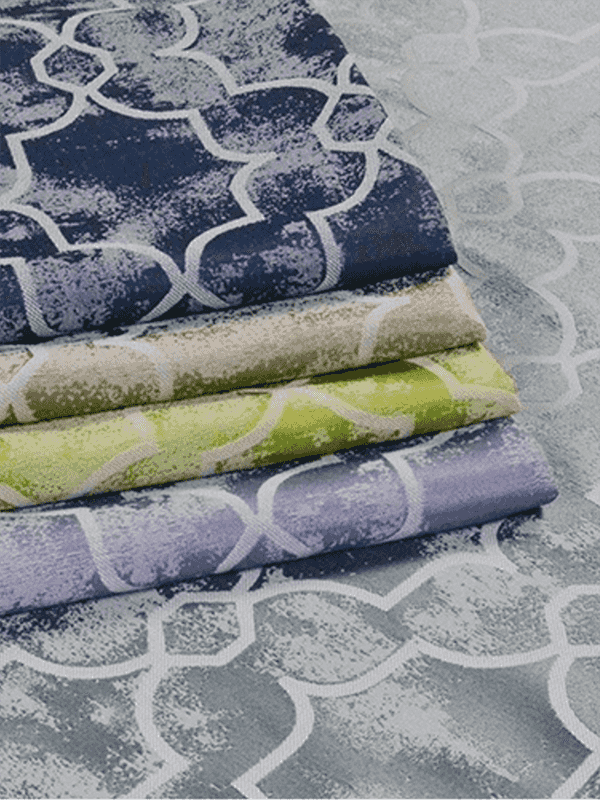Curtains are one of the indispensable home decorations in every family. They not only block the sun and protect privacy, but also increase the beauty and atmosphere of the room. The choice of curtain fabric directly affects the functionality and beauty of the curtains. Whether it is a modern minimalist style or a classical luxury style, suitable curtain fabrics can add a unique charm to the home. Curtain fabric is the main material for making curtains. It is usually made of a variety of fibers, which can be natural fibers such as cotton, linen, and silk, or synthetic fibers such as polyester (polyester), nylon, etc. The texture, thickness, color, and pattern of the curtain fabric directly determine the overall effect of the curtain. Depending on the purpose, the choice of curtain fabric also varies greatly. It can take into account both aesthetics and practicality, such as heat preservation, light blocking, and sound insulation.
Cotton curtain fabric is one of the most common curtain fabrics. It has a natural texture and good breathability, and is suitable for use in spring and summer. Cotton curtains have a good feel, are soft and comfortable, and can bring warmth and affinity to the space. However, cotton fabrics are prone to wrinkles, require frequent ironing, and have poor wrinkle resistance.

Polyester (polyester fiber) is one of the most popular fabrics in modern curtains. It has excellent wear resistance, wrinkle resistance, strong color fastness and is not easy to fade, making it suitable for long-term use. The price of polyester curtain fabrics is relatively affordable and suitable for most families. Polyester fabrics are lighter and less breathable, but they have good light blocking and waterproof properties, making them very suitable for use as sunshade curtains.
Silk curtain fabrics usually present a luxurious and noble feeling, adding elegance and softness to the space. Silk curtain fabrics have a natural luster and a smooth feel, and the brilliance reflected under the light makes the entire space more elegant. Silk fabrics are suitable for modern minimalist or classical style home decoration, but they are more expensive and easily affected by moisture, so special care is required when washing them.
Linen fabrics have a natural texture and a rough texture, and are usually used for decorations that pursue a natural style or a country style. Linen curtain fabric has good air permeability, but due to the characteristics of linen fiber, it is easy to wrinkle and has relatively poor durability. Linen curtain fabric is suitable for use with other materials, such as mixed with cotton, polyester, etc., to increase the beauty and comfort of the curtain.
Velvet curtain fabric is extremely soft, luxurious to the touch, and has a strong sense of luxury. It can effectively isolate the noise from the outside world and has a good sound insulation effect, so it is particularly suitable for use in bedrooms and study rooms, which require a quiet environment. Velvet fabric is thicker and heavier, suitable for winter, and has excellent warmth retention, but it is also easy to get dust and stains, and requires some skills in cleaning and maintenance.
When choosing curtain fabrics, you need to consider factors such as aesthetics, functionality, and budget. Here are some practical suggestions:
The choice of curtain fabric should be coordinated with the overall decoration style of the room. For modern minimalist homes, you can choose polyester or cotton and linen mixed fabrics, which are simple and refreshing; for classic European style or luxury style spaces, you can choose silk or velvet curtain fabrics to increase the nobleness of the space.
Choose the functionality of curtain fabrics according to different needs. If you need stronger light blocking, you can choose thicker polyester fabrics or velvet fabrics, which have better sunshade effects. If you want curtains that can block light and soundproof, velvet fabrics would be a good choice. If it is just for decoration, you can choose cotton or linen curtains with good breathability.
For families in cold areas, choosing warm and thick curtain fabrics such as velvet or polyester will help increase the indoor temperature; while in warm areas, choosing cotton or linen fabrics with good breathability will be more comfortable. The material of the curtains should also take into account the local humidity. Silk and linen fabrics are easily affected by moisture and are suitable for dry environments.
The color and pattern of the curtains need to be coordinated with the walls, furniture and other decorations in the room. Light-colored curtains such as white and beige can create a bright and open sense of space; dark-colored curtains such as dark gray, dark blue, dark purple, etc. appear more stable and mature, and are suitable for use in study rooms, living rooms and other places. In terms of patterns, if you want a simple style, you can choose curtains with monochrome or simple patterns; if you want to add vitality to the space, curtains with rich patterns can bring dynamism and fun to the interior.
Curtain fabrics of different materials have different cleaning methods. Cotton curtains can be machine washed or hand washed, but you need to pay attention to temperature control to avoid shrinkage; silk curtains are best dry-cleaned to avoid damage to the fabric caused by washing; velvet curtains need to be vacuumed regularly to avoid dust accumulation, and can also be washed with special detergents.
Curtain fabrics not only affect the functionality of curtains, but also directly affect the effect of home decoration. When choosing curtain fabrics, make reasonable choices based on home style, functional requirements and seasonal changes. Whether it is to create a warm and comfortable bedroom atmosphere or to add elegance and nobility to the living room, curtain fabrics are an element that cannot be ignored in home decoration. Choose a suitable curtain fabric to give your home space new vitality and charm.

 English
English 中文简体
中文简体 Español
Español عربى
عربى













